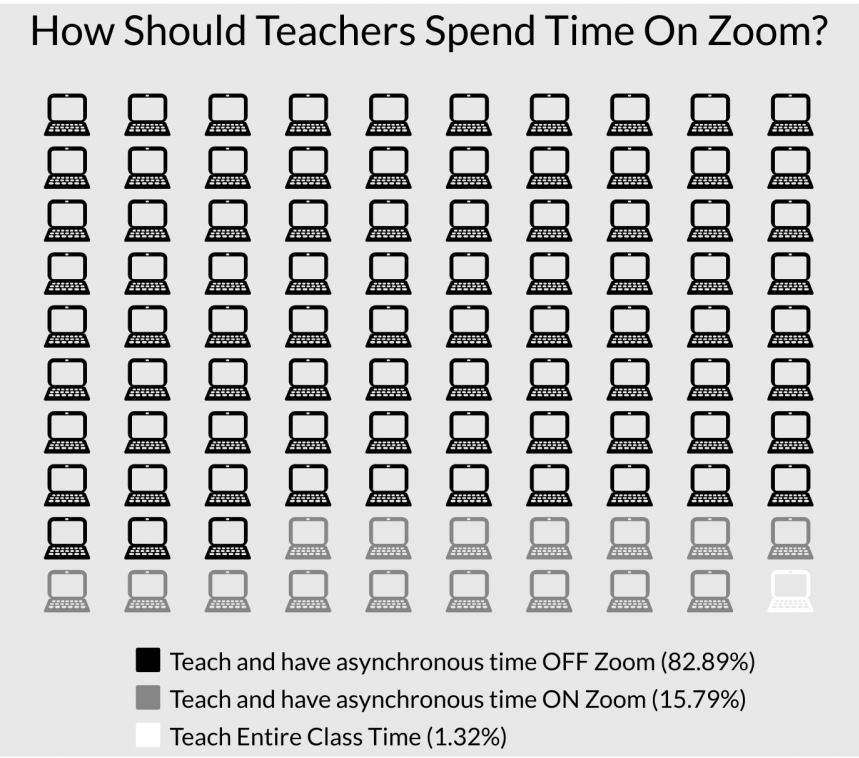Should Teachers Be Using All of Class Time on Zoom?
 Yes
Yes
By Frances Stott
Teachers should use the full 100 minutes of class time over Zoom. There are many benefits to using the whole period.
Many students might feel pressured to finish their work in the small amount of time they would have if classes did not use up the full period.
Teachers should include all of their lessons in class and then have some work time at the end, but all in Zoom.
While teachers shouldn’t be teaching for the full 100 minute class time, they should be keeping their students in for the 100 minutes.
Teachers also need to be available for the students during class. If a student has a question that needs a more immediate answer, the teacher is there to help them.
Being in a Zoom call or another platform, such as Google Meets, for the whole period allows for more direct teacher-student communication.
It also allows for direct discussion during class and the ability to work together. A well-known fact is that homework takes up a lot of time after school.
“American teenagers now average about twice as much time spent on homework each day as their predecessors did in the 1990s,”Joe Pinsker, writer at The Atlantic magazine, said.
If teachers let their students go early without doing even a little bit of homework, students won’t be able to keep up and may feel overwhelmed with the amount of work they have to do.
Teachers letting their students leave early will not allow time for them to look over the homework, and be able to see if there are any topics that weren’t covered.
Teachers can also use the class time to review previous subjects with students after they have taught the new lesson.
While most students might say that they prefer a shorter class period, it can be confusing for their schedule to be constantly changing.
There are many uses for the 100 minute period, and every minute can be used to do something productive.
If the teachers aren’t actively teaching, there are so many other options that would be better than letting their students leave class, and most likely, get distracted.
Zoom time should be used to its full advantage.
No
By Andrew Carpenter
Teachers should not use the whole 100-minute class time. Zoom time is not collaborative, nor is it productive. Teachers should limit the amount of time that is spent on Zoom and make it quick and productive, leaving the work portion of class to be done by yourself.
Zoom calls can cause a lot of stress even if we don’t realize it. According to a Stanford study on video conferencing, having faces in front of you for a long period of time will cause a fight or flight response because it appears that every face is staring at you. In an in-person meeting, people understand social cues such as eye contact or personal space, but a video conference makes both of these harder to comprehend.
Teachers try to make Zoom calls interactive by forcing students to keep their camera on at all times. For many students, this causes stress and anxiety.
”After a long day of Zoom class I feel uneasy because of staring at my peers faces and dealing with the prolonged screen time,” junior Jonathan Ross said.
The constant video conferencing causes negative mental effects on students.
“Our brains are used to picking up body language and other cues. On a video call, something is off, and our subconscious brain is reacting to that,” psychologist Dr. Brenda Wiederhold said.
Teachers don’t need to have the students on the Zoom call for the whole class. They could simply meet for a shorter period of time, assign work, and have the rest of the class time for office hours.
Many people also experience Zoom fatigue, which is when you feel tired after overusing video conferencing such as Zoom, Google Meet, or similar platforms. Many aspects of our lives these days are done over video conferencing. A few examples would be sports practice, school, work, family gatherings, and even doctors appointments.
If teachers used the whole 100 minutes for class on Zoom, this could mean going six hours a day of sitting in front of a computer screen and experiencing the damaging effects of Zoom fatigue for many students.

Andrew Carpenter is the format editor and this is his 2nd year with The Point. Andrew loves fishing, surfing, cooking, and his dog Zuma.